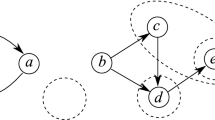Abstract
This is an expository article about the solution to the frame problem proposed in 1980 by Raymond Reiter. For years, his “frame default” remained untested and suspect. But developments in some seemingly unrelated areas of computer science—logic programming and satisfiability solvers—eventually exonerated the frame default and turned it into a basis for important applications.
Similar content being viewed by others
Notes
1 The definition of a default in [22] requires m=1 and n>0. It is convenient for our purposes to allow m and n to be arbitrary nonnegative integers.
2 “Smaller” is understood here in the sense of set inclusion, not in the sense of comparing cardinalities. To make the concept of a minimal model precise, we need to specify whether the extents of predicates other than Ab may be changed as we try to make the extent of Ab smaller; we do not go here into discussing this issue.
4 The definition of an answer set in [6] does not refer to defaults. Instead, it adapts Reiter’s fixpoint construction to the simpler framework of logic programs.
References
Baral, C. (2003). Knowledge Representation, Reasoning and Declarative Problem Solving: Cambridge University Press.
Bidoit, N., & Froidevaux, C. (1987). Minimalism subsumes default logic and circumscription in stratified logic programming. In: Proceedings LICS-87.
Dimopoulos, Y., Nebel, B., Koehler, J. (1997). Encoding planning problems in non-monotonic logic programs In Steel, S., & Alami, R. (Eds.), Proceedings of European Conference on Planning, (pp. 169–181): Springer.
Gebser, M., Kaminski, R., Kaufmann, B., Schaub, T. (2012). Answer Set Solving in Practice. Synthesis Lectures on Artificial Intelligence and Machine Learning: Morgan and Claypool Publishers.
Gelfond, M. (2008). Answer sets In van Harmelen, F., Lifschitz, V., Porter, B. (Eds.), Handbook of Knowledge Representation: Elsevier.
Gelfond, M., & Lifschitz, V. (1991). Classical negation in logic programs and disjunctive databases. New Generation Computing, 9, 365–385.
Gomes, C. P., Kautz, H., Sabharwal, A., Selman, B. (2008). Satisfiability solvers In van Harmelen, F., Lifschitz, V., Porter, B. (Eds.), Handbook of Knowledge Representation, (pp. 89–134): Elsevier.
Haas, A. (1987). The case for domain-specific frame axioms In Brown, F.M. (Ed.), The Frame Problem in Artificial Intelligence, Proceedings 1987 Workshop.
Hanks, S., & McDermott, D. (1987). Nonmonotonic logic and temporal projection. Artificial Intelligence, 33 (3), 379–412.
Kautz, H., & Selman, B. (1992). Planning as satisfiability. In: Proceedings of European Conference on Artificial Intelligence (ECAI).
Leone, N., Pfeifer, G., Faber, W., Eiter, T., Gottlob, G., Perri, S., Scarcello, F. (2006). The DLV system for knowledge representation and reasoning. ACM Transactions on Computational Logic, 7 (3), 499–562.
Lifschitz, V. (2008). What is answer set programming? In: Proceedings of the AAAI Conference on Artificial Intelligence, (pp. 1594–1597): MIT Press.
Lloyd, J. (1987). Foundations of Logic Programming: Springer-Verlag. second, extended edition.
Marek, V., & Truszczynski, M. (1999). Stable models and an alternative logic programming paradigm. In: The Logic Programming Paradigm: a 25-Year Perspective, (pp. 375–398): Springer Verlag.
McCarthy, J. (1986). Applications of circumscription to formalizing common sense knowledge. Artificial Intelligence, 26 (3), 89–116.
McCarthy, J., & Hayes, P. (1969). Some philosophical problems from the standpoint of artificial intelligence In Meltzer, B., & Michie, D. (Eds.), Machine Intelligence (Vol. 4, pp. 463–502). Edinburgh: Edinburgh University Press.
Mueller, E. (2006). Commonsense reasoning: Elsevier.
Niemelä, I. (1999). Logic programs with stable model semantics as a constraint programming paradigm. Annals of Mathematics and Artificial Intelligence, 25, 241–273.
Niemelä, I., & Simons, P. (1997). Smodels—an implementation of the stable model and well-founded semantics for normal logic programs. In: Proceedings 4th Int’l Conference on Logic Programming and Nonmonotonic Reasoning (Lecture Notes in Artificial Intelligence 1265), (pp. 420–429): Springer.
Nogueira, M., Balduccini, M., Gelfond, M., Watson, R., Barry, M. (2001). An A-Prolog decision support system for the Space Shuttle. In: Proceedings of International Symposium on Practical Aspects of Declarative Languages (PADL).
Pylyshyn, Z. W. (1987). Robot’s Dilemma: The Frame Problem in Artificial Intelligence. Westport: Greenwood Publishing Group Inc.
Reiter, R. (1980). A logic for default reasoning. Artificial Intelligence, 13, 81–132.
Reiter, R. (1991). The frame problem in the situation calculus: a simple solution (sometimes) and a completeness result for goal regression In Lifschitz, V. (Ed.), Artificial Intelligence and Mathematical Theory of Computation: Papers in Honor of John McCarthy, (pp. 359–380): Academic Press.
Reiter, R. (2001). Knowledge in Action: Logical Foundations for Specifying and Implementing Dynamical Systems: MIT Press.
Sandewall, E. (1994). Features and Fluents, vol. 1: Oxford University Press.
Schubert, L. (1990). Monotonic solution of the frame problem in the situation calculus: an efficient method for worlds with fully specified actions In Kyburg, H., Loui, R., Carlson, G. (Eds.), Knowledge Representation and Defeasible Reasoning, (pp. 23–67): Kluwer.
Shanahan, M. (1997). Solving the Frame Problem: A Mathematical Investigation of the Common Sense Law of Inertia: MIT Press.
Turner, H. (1997). Representing actions in logic programs and default theories: a situation calculus approach. Journal of Logic Programming, 31, 245–298.
Acknowledgments
Thanks to Yuliya Lierler and to the anonymous referees for comments on a draft of this paper.
Author information
Authors and Affiliations
Corresponding author
Additional information
This research was partially supported by the National Science Foundation under Grant IIS-1422455.
Rights and permissions
About this article
Cite this article
Lifschitz, V. The Dramatic True Story of the Frame Default. J Philos Logic 44, 163–176 (2015). https://doi.org/10.1007/s10992-014-9332-8
Received:
Accepted:
Published:
Issue Date:
DOI: https://doi.org/10.1007/s10992-014-9332-8



